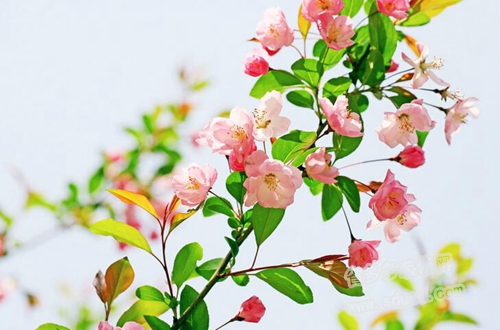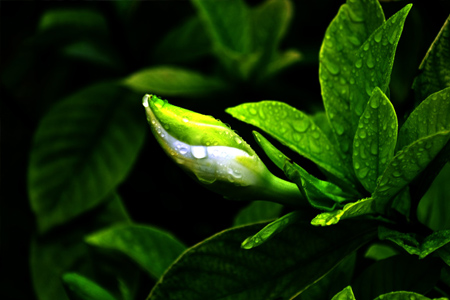Crabapple flower culture techniques: what are the species of crabapple flowers? How to reproduce?
Begonia flower, also known as begonia, pear blossom begonia. It is a small deciduous tree flower of Rosaceae. It can be as high as 7 murals and 8 meters. Flowers are often clustered, buds are red, pink after blooming, very gorgeous, 4mur5cm in diameter. The florescence is from April to May.
Crabapple flowers are native to China. It is distributed in Zhejiang, Hebei, Shaanxi, Shandong, Jiangsu and other provinces. More gardens are cultivated everywhere. Like plenty of sunshine, avoid stagnant water, drought resistance, shy and cold.
The varieties, forms and varieties of begonia flowers are as follows:
[West House Begonia] is also known as Red Begonia. The leaf is broad, the flower is big, pink, do it again.
[Bai Haitang] also known as re-run Bai Haitang. The flowers are rearranged, white or reddish.
The color of the flower is pink and red. Because the pedicel is slender and drooping: Xunming hanging silk begonia. There are two variants.
White flower hanging silk begonia: the flower is white.
Redo Tripterygium: pollen red, redo.
The commonly used propagation methods are sowing, grafting, striping, root insertion, ramet and so on. Mainly by grafting.
[sowing] the sowing method is the same as other tree species of Rosaceae. A large number of seedlings can be obtained, but it is not easy to preserve the excellent characteristics of the mother plant, and it blossoms later, which usually takes 8 years to blossom.
There are two methods of bud grafting and branch grafting. Rootstock with bauhinia, real begonia seedlings, flower red, du pear, sand fruit, apple, Jiaozi, wild begonia and so on. Branch grafting (cutting, splitting) is carried out within 10 days before and after the Rain and Water Festival. Budding took place in August.
The crabapple flower sprouts more, bends the sprouting branch into the soil from the rhizosphere, cuts the skin, and takes root a year later.
[root insertion] it takes place from February to March in early spring. Combined with ramet, transplanting was carried out, and the sturdy root with a diameter of 0.5 mi 1.0 cm was cut into cuttings of 10 mi 15 cm, and the cuttings were cut in the seedbed. Always keep it moist and shady. The survival rate is more than 85%.
[ramet] is the same as the general ramet method.
Planting soil requires loose, fertile and good drainage. The soil should be fertilized every autumn. Pruning withered and diseased branches in spring, keeping the tree shape ventilated, transparent and beautiful, adjusting nutrition balance, fertilizing and watering once in early spring, watering before and after flowering. Pay attention to the harm of aphids, beetles, red spiders, bark moths, longicorn beetles and so on. Can be diluted with 4096 dimethoate 1000ml 1500 times water spray to kill aphids, beetles, red spiders. Bark moths and longicorn beetles need to strictly prevent their larvae from eating branches. When wormholes are found, they are injected into wormholes with dichlorvos, and then sealed with soil to kill pests.
Begonia flowers luxuriant, colorful, spring flowers, the sun shining, into the autumn red fruit branches, fresh and unusual. There is a unique grace in the garden flowers and trees. Therefore, it is one of the famous garden flowers and trees in China. It can be used as a secluded path street tree, around the pavilion, the edge of the jungle lawn, one side of the building, riverside pool, solitary planting piece can be planted. Potted cut flowers are all very beautiful. It is sensitive to chlorine and hydrogen chloride and can be used as a monitoring pollution tree species.
What are the kinds of crabapple flowers? How should it reproduce?
Begonia flower, also known as begonia, pear blossom begonia. It is a small deciduous tree flower of Rosaceae. It can be as high as 7 murals and 8 meters. Flowers are often clustered, buds are red, pink after blooming, very gorgeous, 4mur5cm in diameter. The florescence is from April to May.
The varieties, forms and varieties of begonia flowers are as follows:
[West House Begonia] is also known as Red Begonia. The leaf is broad, the flower is big, pink, do it again.
[Bai Haitang] also known as re-run Bai Haitang. The flowers are rearranged, white or reddish.
The color of the flower is pink and red. Because the pedicel is slender and drooping: Xunming hanging silk begonia. There are two variants.
[White flower drooping silk begonia] the flowers are white.
[rescheduling Begonia] Pollen red, redo.
Begonia flowers luxuriant, colorful, spring flowers, the sun shining, into the autumn red fruit branches, fresh and unusual. There is a unique grace in the garden flowers and trees. Therefore, it is one of the famous garden flowers and trees in China. It can be used as a secluded path street tree, around the pavilion, the edge of the jungle lawn, one side of the building, riverside pool, solitary planting piece can be planted. Potted cut flowers are all very beautiful. It is sensitive to chlorine and hydrogen chloride and can be used as a monitoring pollution tree species.
Mainly by grafting.
The main results are as follows: 1. The sowing method is the same as other tree species of Rosaceae. A large number of seedlings can be obtained, but it is not easy to preserve the excellent characteristics of the mother plant, and it blossoms later, which usually takes 8 years to blossom.
Rootstock with bauhinia, real begonia seedlings, flower red, du pear, sand fruit, apple, Jiaozi, wild begonia and so on. Budding took place in August.
3. Striping is carried out before sprouting in early spring. The crabapple flower sprouts more, bends the sprouting branch into the soil from the rhizosphere, cuts the skin, and takes root a year later. Always keep the soil moist and remove and transplant the following spring with some roots.
4. Root insertion is carried out from February to March in early spring. Combined with ramet, transplanting was carried out, and the sturdy root with a diameter of 0.5 mi 1.0 cm was cut into cuttings of 10 mi 15 cm, and the cuttings were cut in the seedbed. Always keep it moist and shady. The survival rate is more than 85%.
Planting soil requires loose, fertile and good drainage. The soil should be fertilized every autumn. Pruning withered and diseased branches in spring, keeping the tree shape ventilated, transparent and beautiful, adjusting nutrition balance, fertilizing and watering once in early spring, watering before and after flowering. Pay attention to the harm of aphids, beetles, red spiders, bark moths, longicorn beetles and so on. Can be diluted with 4096 dimethoate 1000ml 1500 times water spray to kill aphids, beetles, red spiders. Bark moths and longicorn beetles need to strictly prevent their larvae from eating branches. When wormholes are found, they are injected into wormholes with dichlorvos, and then sealed with soil to kill pests.
Introduction to the culture methods of crabapple flowers
Crabapple flower has been a favorite object of writers and writers since ancient times, and it is reflected in many literary works and poems. Su Dongpo, a great writer, is fascinated by it and has a famous phrase "only afraid of sleeping late at night, so burning high candles according to red makeup". Therefore, Haitang has the elegant name "Xie Yuhua". Begonia also has a high ornamental value. Haitang is known as "Guoyan".

Species of crabapple flowers
There are 35 species of Malus, most of which are from warm temperate zone to cold temperate zone. There are about 20 species in China, which is the distribution center of Malus.
The crabapple flower usually refers to a flower and tree of the genus Begonia in the rose family, which is up to 8 meters high. The tree has an ovate crown and is mostly shrub-shaped. Leaves oval to long oval, 5 to 8 cm long, marginal teeth dense and close, petiole 1.5-2 cm long. Inflorescences subumbellate, with 4-6 flowers, pedicels 2-3 cm long, petals ovate, pink in bud, white after opening. The fruit is nearly spherical and slightly flat, yellow when ripe, 2-2.5 cm in diameter, 3-4 cm long, pedicel depression and calyx depression are raised, calyx often persistent. There are two varieties of begonia flowers: double white begonia with white flowers and double red flowers with dark pink flowers.
Species of crabapple flowers
For the cultivation of begonia flowers, begonia flowers can be propagated and cultivated by sowing, ramet and grafting. Generally, begonia can be sowed in autumn or spring. Begonia grows very slowly, and it takes about 5 years from planting to flowering. Begonia flower is a very hardy plant, because growing crabapple in the south can be put outdoors. Crabapple flowers usually blossom once a year, and the flowering season is in spring.
Culture method of crabapple flower
The planting of begonia should also pay attention to the control of moisture. The soil for planting begonia should always be kept moist. In the dry season, spraying water can be used to increase the humidity of the air. It is necessary to help potted begonia not to deposit too much water. Otherwise, it will cause the root of begonia to rot. In the fertilization of crabapple flowers, we should be careful not to splash fertilizer on the leaves. It should also be noted that begonia flowering and summer are not suitable for fertilization.
Some people call the crabapple flower as the heartbroken flower, which expresses a kind of parting sadness, and the crabapple flower also expresses the traveller's homesickness and parting sadness, so the flower language of the crabapple flower also has a kind of meaning of "bitter love".
- Prev

How many kinds of crabapple flowers are there? How to maintain and manage?
Begonia is native to China and is widely cultivated in the north of the Yangtze River valley. It has a long history and is a traditional famous flower in China. There is no lack of planting in classical gardens, often forming independent scenic spots, in the name of flowers, such as "Begonia Chunwu". Architectural decoration also often uses begonia pattern to design doors and windows, walls and roads, which can be seen everywhere, giving people the enjoyment of beauty.
- Next

Why do gardenia leaves turn yellow?
There are many reasons for the yellowing of gardenia leaves, and the common one is caused by "chlorosis" caused by physiological diseases. Whether potted or cultivated in the ground, if the soil is alkaline or iron deficient, it is more common. Iron deficiency is characterized by the loss of green and yellowing between the veins of young leaves, and seriously yellowing the leaves of the whole plant.
Related
- Fuxing push coffee new agricultural production and marketing class: lack of small-scale processing plants
- Jujube rice field leisure farm deep ploughing Yilan for five years to create a space for organic food and play
- Nongyu Farm-A trial of organic papaya for brave women with advanced technology
- Four points for attention in the prevention and control of diseases and insect pests of edible fungi
- How to add nutrient solution to Edible Fungi
- Is there any good way to control edible fungus mites?
- Open Inoculation Technology of Edible Fungi
- Is there any clever way to use fertilizer for edible fungus in winter?
- What agents are used to kill the pathogens of edible fungi in the mushroom shed?
- Rapid drying of Edible Fungi

